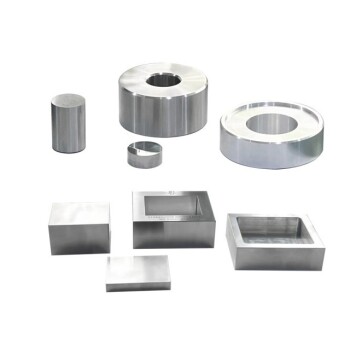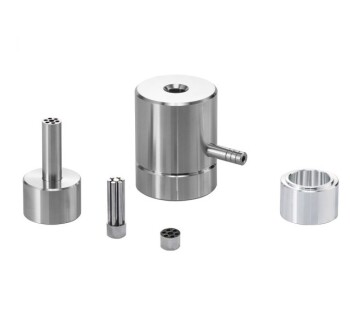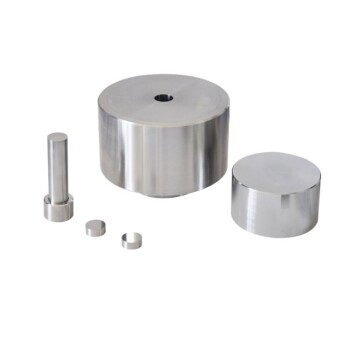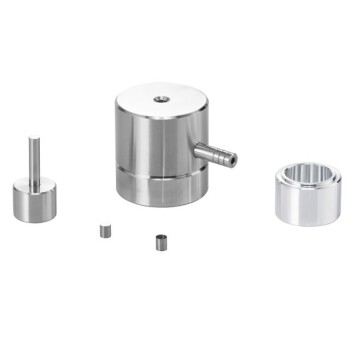In materials science, hot pressing is a high-performance consolidation process that uses simultaneous heat and uniaxial pressure to transform powders into dense, solid materials. By applying both thermal energy and mechanical force at the same time, it dramatically reduces the porosity that weakens materials, creating components with superior density, strength, and stability.
The core challenge in creating advanced materials is eliminating the microscopic voids between particles. Hot pressing solves this by using pressure to physically force particles together while heat enables them to bond, resulting in a dense, homogenous structure that is often unachievable by other means.
The Fundamental Mechanism: Combining Heat and Pressure
Hot pressing is more than just heating and squeezing; it's about the powerful synergy between these two forces. Understanding this interaction is key to understanding its value.
How Heat Enables Particle Bonding
Heat provides the thermal energy necessary for a process called sintering. This allows atoms to move, or diffuse, across the boundaries of individual particles, essentially welding them together on a microscopic level.
However, relying on heat alone (conventional sintering) often requires very high temperatures and long processing times, which can lead to undesirable grain growth that weakens the final material.
How Pressure Forces Densification
The application of high, directional pressure mechanically forces the material's particles into a tighter arrangement. This process physically closes the gaps and pores between particles, directly attacking the root cause of poor mechanical properties.
The Synergistic Effect
When applied simultaneously, pressure reduces the temperature and time needed for effective sintering to occur. The pressure brings particle surfaces into intimate contact, making it far easier for atomic diffusion and bonding to happen, leading to a much denser and more uniform structure in a fraction of the time.
Key Outcomes Enabled by Hot Pressing
The unique combination of heat and pressure unlocks specific material transformations that are critical for high-performance applications.
Achieving Near-Theoretical Density
The primary goal of hot pressing is densification. By physically eliminating voids and pores, the process can produce materials that approach 100% of their theoretical maximum density. This directly translates to dramatic improvements in mechanical strength, hardness, and thermal conductivity.
Driving Phase Transformations
The extreme conditions inside a hot press can force a material's atomic structure to change into a different, often more desirable, crystalline phase. This allows for the creation of materials with enhanced properties, such as improved hardness or thermal stability, that do not exist under normal conditions.
Facilitating Solid-Phase Reactions
Hot pressing is an excellent method for bonding dissimilar materials. It can force two or more different powders to react and diffuse into one another in their solid state, creating novel composites, alloys, and functionally graded materials with tailored properties.
Understanding the Trade-offs and Considerations
While powerful, hot pressing is a specialized technique with its own set of advantages and limitations.
The Advantage of Speed
Compared to conventional sintering, hot pressing often involves significantly shorter cycle times. For research and development, this is a massive advantage, as it accelerates the iterative process of material testing and discovery.
The Need for a Controlled Atmosphere
Because of the high temperatures involved, many materials are susceptible to oxidation, which can degrade their properties. For this reason, hot pressing is frequently performed in a vacuum or an inert gas environment to protect the material during consolidation.
Limitations in Geometry and Cost
The equipment for hot pressing is complex and expensive. Furthermore, because pressure is typically applied along a single axis, the process is best suited for producing parts with relatively simple geometries, such as discs, plates, or cylinders.
How to Apply This to Your Project
Choosing a manufacturing process depends entirely on your end goal. Hot pressing is not a universal solution, but it is an invaluable tool for specific, high-stakes objectives.
- If your primary focus is maximum density and mechanical strength: Hot pressing is the ideal choice for creating components that are virtually free of porosity and can withstand extreme stress.
- If your primary focus is developing novel composites or alloys: Use hot pressing to force solid-state reactions and create strong bonds between materials that would not normally fuse together.
- If your primary focus is rapid research and development: The short cycle times of hot pressing can dramatically accelerate your timeline for creating and testing new material formulations.
Ultimately, hot pressing empowers engineers and scientists to create materials that push beyond conventional performance limits.
Summary Table:
| Aspect | Key Details |
|---|---|
| Process | Simultaneous heat and uniaxial pressure to consolidate powders |
| Main Benefits | High density, improved strength, faster cycle times, phase transformations |
| Ideal Applications | High-performance components, composites, alloys, rapid R&D |
| Limitations | Simple geometries, high equipment cost, controlled atmosphere needed |
Ready to enhance your laboratory's material capabilities with precision hot pressing? KINTEK specializes in lab press machines, including automatic, isostatic, and heated presses, designed to deliver superior density, strength, and efficiency for your research needs. Contact us today to discuss how our solutions can accelerate your projects and achieve breakthrough results!
Visual Guide
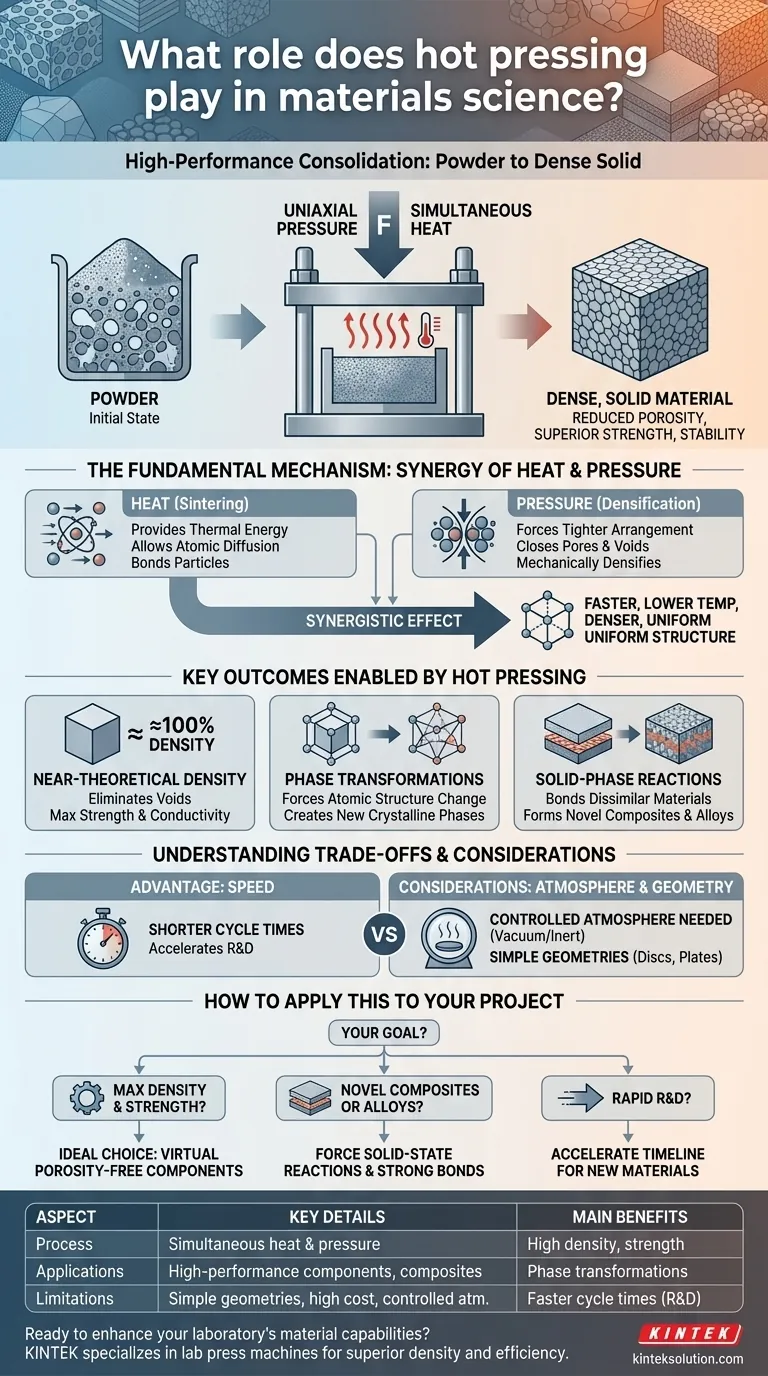
Related Products
- Automatic High Temperature Heated Hydraulic Press Machine with Heated Plates for Lab
- Lab Heat Press Special Mold
- Automatic Heated Hydraulic Press Machine with Hot Plates for Laboratory
- Laboratory Manual Heated Hydraulic Press Machine with Hot Plates
- Manual Heated Hydraulic Lab Press with Integrated Hot Plates Hydraulic Press Machine
People Also Ask
- What is a heated hydraulic press and what are its main components? Discover Its Power for Material Processing
- Why is a hydraulic heat press critical in research and industry? Unlock Precision for Superior Results
- How are heated hydraulic presses utilized in material testing and sample preparation? Enhance Your Lab's Precision and Efficiency
- What role does a heated hydraulic press play in powder compaction? Achieve Precise Material Control for Labs
- Why is a heated hydraulic press considered a critical tool in research and production environments? Unlock Precision and Efficiency in Material Processing

